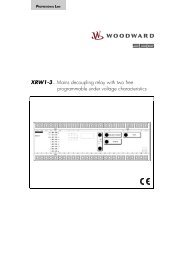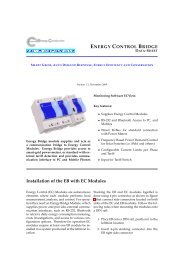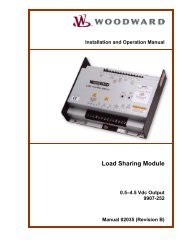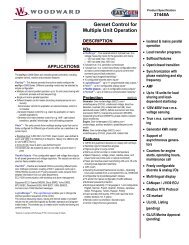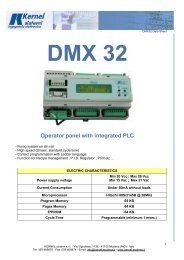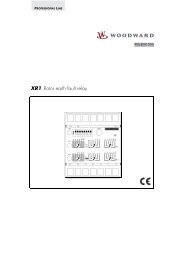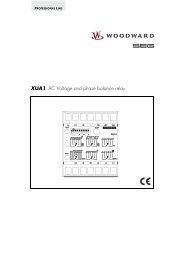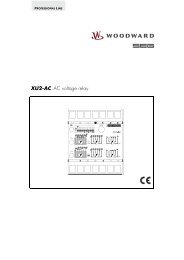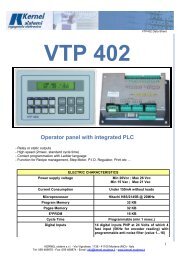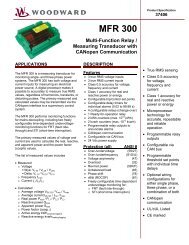XP2-R â Power and reverse power relay
XP2-R â Power and reverse power relay
XP2-R â Power and reverse power relay
Create successful ePaper yourself
Turn your PDF publications into a flip-book with our unique Google optimized e-Paper software.
<strong>XP2</strong>-R – <strong>Power</strong> <strong>and</strong> <strong>reverse</strong> <strong>power</strong> <strong>relay</strong>(January 2006)Manual <strong>XP2</strong>-R (Revision New)
WoodwardManual <strong>XP2</strong>-R GBWoodward Governor Company reserves the right to update any portion of this publication at any time. Informationprovided by Woodward Governor Company is believed to be correct <strong>and</strong> reliable. However, no responsibility is assumedby Woodward Governor Company unless otherwise expressly undertaken.© Woodward 1994-20082 TD_<strong>XP2</strong>-R_01.06_GB_Rev.New
Manual <strong>XP2</strong>-R GBWoodwardContents1. Applications <strong>and</strong> features ........................................................................... 42. Design ........................................................................................................... 53. Function ........................................................................................................ 73.1 Measuring principle ........................................................................................................... 73.2 Calculation of the setting value at <strong>reverse</strong> <strong>power</strong> .............................................................. 84. Operation <strong>and</strong> settings .............................................................................. 104.1 Setting of DIP-switches ................................................................................................... 114.2 Setting of the tripping values ........................................................................................... 124.3 Communication via serial interface adapter XRS1 .......................................................... 135. Relay case <strong>and</strong> technical data .................................................................. 145.1 Relay case ...................................................................................................................... 145.2 Technical data ................................................................................................................. 156. Order form ................................................................................................... 17TD_<strong>XP2</strong>-R_01.06_GB_Rev.New 3
WoodwardManual <strong>XP2</strong>-R GB1. Applications <strong>and</strong> featuresRelay <strong>XP2</strong>-R of the PROFESSIONAL LINE is a digital <strong>relay</strong> for <strong>reverse</strong> <strong>power</strong> detection of gen.-sets in parallel <strong>and</strong> active <strong>power</strong> supervision of <strong>power</strong> systems.For generators operating in parallel with a mains or another generator, it is imperative to supervisethe <strong>power</strong> direction. If for example the prime mover fails the alternator operates as a motor <strong>and</strong>drives the prime mover (diesel or turbine). The <strong>XP2</strong>-R detects the <strong>reverse</strong> of the <strong>power</strong> direction<strong>and</strong> - in case of this error - switches off the alternator. This way, <strong>power</strong> losses <strong>and</strong> damages of theprime mover are avoided.When compared to conventional protection equipment all <strong>relay</strong>s of the PROFESSIONAL LINE reflectthe superiority of digital protection technique with the following features:• High measuring accuracy by digital processing• Fault indication via LEDs• Extremely wide operating ranges of the supply volt-age by universal wide range <strong>power</strong>supply unit• Very fine graded wide setting ranges• Data exchange with process management system by serial interface adapter XRS1 whichcan be retrofitted• True <strong>power</strong> measurement by multiplication of current <strong>and</strong> voltage• Extremely short response time• Adjustment of rated data• Compact design by SMD-technologyIn addition to this <strong>relay</strong> <strong>XP2</strong>-R has the following special features:• Measurement phase-to-neutral or phase-to-phase voltage possible• Tripping times for supervision P <strong>and</strong> PR adjustable4 TD_<strong>XP2</strong>-R_01.06_GB_Rev.New
Manual <strong>XP2</strong>-R GBWoodward2. DesignFigure 2.1: Connection three-wire systemFigure 2.2: Connection phase-to-phase voltage in four-wire systemFigure 2.3: Connection phase-to-neutral voltage in four-wire systemTD_<strong>XP2</strong>-R_01.06_GB_Rev.New 5
WoodwardManual <strong>XP2</strong>-R GBAnalog inputsThe analog input signals are connected to the protection device via voltage terminals1L - 2L <strong>and</strong>current terminals 1S1 (K-terminal of transformer ) - 1S2 (L-terminal of transformer).Auxiliary voltage supplyThe <strong>XP2</strong>-R can be supplied directly from the measuring quantity itself or by secured aux. supply.Therefore a DC or AC voltage must be used.Unit <strong>XP2</strong>-R has an integrated wide range <strong>power</strong> supply. Voltages in the range from 19 - 55 V DCcan be applied at connection terminals A1(L-) <strong>and</strong> A2(L+). Terminals A1/A3 are to be used for voltagesfrom 50 - 750 V DC or from 36 - 520 V AC.Contact positionsFigure 2.4: Contact positions of the output <strong>relay</strong>s6 TD_<strong>XP2</strong>-R_01.06_GB_Rev.New
Manual <strong>XP2</strong>-R GBWoodward3. FunctionThe incoming current from the main current transformer of the protected object is converted to avoltage signal in proportion to the current via the input transformer <strong>and</strong> burden. The noise signalscaused by inductive <strong>and</strong> capacitive coupling are suppressed by an analog R-C filter circuit.The analog voltage signals are fed to the A/D-converter of the microprocessor <strong>and</strong> transformed todigital signals through Sample- <strong>and</strong> Hold- circuits. The measuring value detection takes with asampling frequency of 12 x fn, namely, a sampling rate of 1.66 ms for every measuring quantity at50 Hz.3.1 Measuring principleThrough multiplication of the actual current <strong>and</strong> voltage values p(t) = u(t) • i(t), the microprocessorcalculates the phase <strong>power</strong>. 12 instantaneous values are measured <strong>and</strong> recorded per cycle. Afterwardsthe <strong>power</strong> value during one cycle is determined. 1 Consequently, the total three phase current is calculated from: P total = P1 + P2 + P3Figure 3.1: Diagram of <strong>power</strong> calculationTD_<strong>XP2</strong>-R_01.06_GB_Rev.New 7
WoodwardManual <strong>XP2</strong>-R GB3.2 Calculation of the setting value at <strong>reverse</strong> <strong>power</strong>Should the <strong>relay</strong>, for instance, trip at a generator re-verse <strong>power</strong> of 10 %, this does not mean thatthe set-ting value of the <strong>XP2</strong>-R is 10 %. Based on the trans-former transformation ratio, the switchingpoint has to be calculated.The <strong>XP2</strong>-R measures the <strong>power</strong> in one phase of the transformer secondary side. The <strong>power</strong> is assumedto be symmetricalThe generator phase <strong>power</strong> must be related to the transformers secondary side.Essential dataSG[kVA]cos(φ):In:Un:n I :n U :rated generator apparent <strong>power</strong>rated generator <strong>power</strong> factorrated current of <strong>XP2</strong>-Rrated voltage of <strong>XP2</strong>-Rtransformation ratio of the CTtransformation ratio of the VTConnection of the <strong>XP2</strong>-R to phase-to-phase voltage:Conversion of the generator phase <strong>power</strong> PGS based on the CT secondary side: ·cos √3 · · With the permissible generator <strong>reverse</strong> <strong>power</strong> PGS , the setting value PR is then calculated as follows: % ·cos√3 · · · · %Calculation example 1: Medium voltage 10 kV (see fig. 2.1)• generator apparent <strong>power</strong>: SG = 1875 kVA• rated <strong>power</strong> factor: cos(φ) = 0,8• rated voltage of <strong>XP2</strong>-R: Un = 110 V (phase-to-phase voltage)When the <strong>relay</strong> is expected to trip at a generator re-verse <strong>power</strong> of 6 %, calculation of the settingvalue is as follows: % 1875 · 0.8√3 · 20 · 100110 · 5·6% 5%According to the above example, the <strong>XP2</strong>-R has to be set to 5 % so that it trips at a generator <strong>reverse</strong><strong>power</strong> of 6 % (rated generator active <strong>power</strong>).Connection of the <strong>XP2</strong>-R to phase-to-neutral voltageConversion of the generator phase <strong>power</strong> PGS based on the transformer secondary side: ·cos 3· · 8 TD_<strong>XP2</strong>-R_01.06_GB_Rev.New
Manual <strong>XP2</strong>-R GBWoodwardWith the permissible generator <strong>reverse</strong> <strong>power</strong> P GS , the setting value P R is then calculated as follows: ·cos 3· · Calculation example 2: Low voltage 400 V, connec-tion to phase voltage (see fig. 2.3)• generator apparent <strong>power</strong>: S G = 625 kVA• rated <strong>power</strong> factor: cos(φ) = 0,8• rated current of <strong>XP2</strong>-R: In = 5 A• rated voltage of <strong>XP2</strong>-R: Un = 230 V (phase-to-neutral voltage)• transformation ratio of the CT: n I = 1000 A / 5 A• no VT requiredWhen the <strong>relay</strong> is expected to trip at a generator re-verse <strong>power</strong> P RG of 5 %, calculation of the settingvalue P R> is as follows: % 625 · 0,83 · 1 · 200230 · 5·5% 3.6%4%According to the above example, the <strong>XP2</strong>-R has to be set to 4 % so that it trips at a generator <strong>reverse</strong><strong>power</strong> of 5 % (rated generator active <strong>power</strong>).TD_<strong>XP2</strong>-R_01.06_GB_Rev.New 9
WoodwardManual <strong>XP2</strong>-R GB4. Operation <strong>and</strong> settingsAll operating elements needed for setting parameters are located on the front plate of unit <strong>XP2</strong>-Ras well as all display elements.Because of this all adjustments of the unit can be made or changed without disconnecting the unitfrom DIN-rail.Figure 4.1: Front plateFor adjustment of the unit the transparent cover has to be opened as illustrated. Do not use force!The trans-parent cover has two inserts for labels.Figure 4.2: How to open the transparent cover10 TD_<strong>XP2</strong>-R_01.06_GB_Rev.New
Manual <strong>XP2</strong>-R GBWoodwardLEDsLED "ON" is used for display of the readiness for ser-vice (at applied auxiliary voltage Uv) <strong>and</strong> besidesthis it flashes at wrong phase sequence (see table under para. 4.1). LEDs P> <strong>and</strong> P< signalpickup (flashing) or tripping (steady light) of the respective function.Test push buttonThis push button is used for test tripping of the unit <strong>and</strong> when pressed for 5 s a check-up of thehardware takes place. Both output <strong>relay</strong>s are tripped <strong>and</strong> all tripping LEDs light up.4.1 Setting of DIP-switchesThe DIP-switch block on the front plate of unit <strong>XP2</strong>-R is used for adjustment of the nominal values<strong>and</strong> setting of function parameters:DIP-switch OFF ON Function1* Un = 100 V Un = 110 V Setting of rated voltage2* Un = 100 V Un = 230 V3* Un = 100 V Un = 400 V45 Y Measuring phase-to-neutral/phase-to-phase voltage6 500 ms 40 ms Returning time7 x 1 x 10 Multiplier for tPR>8 x 1 x 10 Multiplier for tP>Table 4.1: Function of DIP-switches*Only one of the DIP-switches 1 - 3 shall be in „ON“ position at the same time.Rated voltageThe required rated voltage can be set with the aid of DIP-switch 1 - 3 to 100, 110, 230 or 400 V AC.The rated voltage is defined as the real connected voltage applied to connection terminals1L - 2L. It has to be ensured that only one of the three DIP-switches is switched on. The followingDIP-switch configurations for adjustment of the rated voltage are allowed.Figure 4.3: Adjustment of rated voltageRated voltage chosen too low does not cause destruction of the unit but leads to wrong measuringresults which may lead to false trippings.TD_<strong>XP2</strong>-R_01.06_GB_Rev.New 11
WoodwardManual <strong>XP2</strong>-R GBMeasuring of phase-to-neutral/phase-to-phase volt-ageThe phase-to-neutral (position „OFF“) or phase-to-phase voltage (position „ON“) can be adjustedby means of switching over the DIP-switch 5.Hysteresis of P> <strong>and</strong> PR>The hysteresis of both trip elements are fixed to 0.8 % Pn.Example:The chosen rated voltage is 400 V.The rated current is 5 A.400 V x 5 A x 0.8 % = 16 W hysteresisReturning timeIf DIP-switch 6 is in ON position, the returning time of P> <strong>and</strong> PR> is 40 ms. At the same time thetripping values of tPR> <strong>and</strong> tP> are set to their minimum values irrespectively of their potentiometersetting.This setting is only used together with a XG2 <strong>relay</strong> as <strong>power</strong> direction controlled vector surge trippingfor synchronous motors.4.2 Setting of the tripping valuesThe PROFESSIONAL LINE units have the unique possibility of high accuracy fine adjustments. Forthis, two potentiometers are used. The course setting potentiometer can be set in discrete steps of5 % (or 20 %). A second fine adjustment potentiometer is then used for continuously variable settingof the final 0 - 5 % (or 0 - 20 %). Adding of the two values results in the precise tripping value.Active <strong>power</strong> supervisionThe tripping value can be set in the range from1 - 120 % Pn with the aid of the potentiometer illustrated on the following diagram.Example:A tripping value P> of 72 % Pn is to be set. The set value of the right potentiometer is just added tothe value of the coarse setting potentiometer. (The arrow of the coarse setting potentiometer mustbe inside of the marked bar, otherwise no defined setting value).Figure 4.4: Adjusting exampleReverse <strong>power</strong> supervisionThe tripping value at <strong>reverse</strong> <strong>power</strong> is adjustable in the range from 1 - 30 % Pn. The adjustment ismade as shown above.Time delayThe time delays of both <strong>power</strong> elements can beadjusted in the range from 0 - 10 s or 0 - 100 s continuously variable (pay attention to range shiftingof DIP-switch 7 <strong>and</strong> 8)12 TD_<strong>XP2</strong>-R_01.06_GB_Rev.New
Manual <strong>XP2</strong>-R GBWoodward4.3 Communication via serial interface adapter XRS1Figure 4.5: Communication principleFor communication of the units with a superior management system, the interface adapter XRS1 isavail-able for data transmission, including operating software for our <strong>relay</strong>s. This adapter can easilybe retrofitted at the side of the <strong>relay</strong>. Screw terminals simplify its installation. Optical transmissionof this adapter makes galvanic isolation of the <strong>relay</strong> possible. Aided by the software, actual measuredvalues can be processed, <strong>relay</strong> parameters set <strong>and</strong> protection functions programmed at theoutput <strong>relay</strong>s. Information about unit XRS1 in detail can be taken from the description of this unit.TD_<strong>XP2</strong>-R_01.06_GB_Rev.New 13
WoodwardManual <strong>XP2</strong>-R GB5. Relay case <strong>and</strong> technical data5.1 Relay caseUnit <strong>XP2</strong>-R is designed to be fastened onto a DIN-rail acc. to DIN EN 50022, same as all units ofthe PROFESSIONAL LINE.The front plate of the unit is protected with a sealable transparent cover (IP40).Figure 5.1: Dimensional drawingsConnection terminalsThe connection of up to a maximum of 2 x 2.5 mm2 cross-section conductors is possible. For thisthe transparent cover of the unit has to be removed (see para. 4).14 TD_<strong>XP2</strong>-R_01.06_GB_Rev.New
Manual <strong>XP2</strong>-R GBWoodward5.2 Technical dataMeasuring input circuitsRated voltage Un:Rated frequency range:<strong>Power</strong> consumption involtage circuit:<strong>Power</strong> consumptionin current circuit:Working range of <strong>power</strong> supervisionvoltage:current:Thermal capacityof the voltage circuit:Thermal load carrying capacityof the current circuit:100,110, 230, 400 V AC35 - 74 Hz1 VAIn = 1 A/0,075 VAIn = 5 A/0,1 VA40 - 130 % Un0 - 120 % Incontinuously 520 V ACcontinuously 4 x InAuxiliary voltageRated auxiliary voltage UV/ 36 - 520 V AC (f = 35 - 78 Hz) or 50 - 750 V DC /4 W (terminals A1 - A3)<strong>Power</strong> consumption:19 - 55 V DC/3 W (terminals A1(L-) - A2(L+))Common dataDropout to pickup ratio:Resetting time from pickup:Returning time from trip:Minimum initialization time aftersupply voltage has applied:Minimum response time whensupply voltage is available:0,8 % von Pn
WoodwardManual <strong>XP2</strong>-R GBSystem dataDesign st<strong>and</strong>ard: VDE 0435 T303; IEC 0801 part 1-4; VDE 0160;IEC 255-4; BS142; VDE 0871Temperature range:at storage <strong>and</strong> operation: - 25°C to + 70°CConstant climate class Facc. to DIN 40040 <strong>and</strong>DIN IEC 68, T.2-3:more than 56 days at 40°C <strong>and</strong> 95 % relative humidityHigh voltage test acc. to VDE 0435, part 303Voltage test:2.5 kV (eff.) / 50 Hz; 1 minSurge voltage test:5 kV; 1.2/50 ms, 0.5 JHigh frequency test:2.5 kV / 1 MHzElectrostatic discharge (ESD)acc. to IEC 0801, part 2:Radiated electromagnetic fieldtest acc. to IEC 0801, part 3:Electrical fast transient (burst)acc. to IEC 0801, part 4:Radio interference suppressiontest acc. to DIN 57871 <strong>and</strong>VDE0871:8 kV10 V/m4 kV / 2,5kHz, 15 mslimit value class ARepeat accuracy: 1 %Basic time delay accuracy:0.5 % or ±50 msAccuracy of the specific rated values: Un = 100 V / 110 V / 230 V / 400 V 1 % PnTemperature effect:0.02 % as per KFrequency effect:45 - 66 Hz no tolerance35 - 45 Hz <strong>and</strong> 66 - 74 Hz 1%Min. threshold valueof <strong>power</strong> elements:1 % of PnMechanical test:Shock: class 1 to DIN IEC 255-21-2Vibration: class 1 to DIN IEC 255-21-1Degree of protectionFront plate:IP40 at closed front coverWeight:ca. 0.7 kgMounting position:anyRelay case material:self-extinguishingParameter Setting range GraduationPR> 1 - 30 % Pn continuously variableP> 1 - 120 % Pn continuously variabletPR> 0 - 10 s/0 - 100 s continuously variabletP> 0 - 10 s/0 - 100 s continuously variableTable 5.1: Setting ranges <strong>and</strong> graduation16 TD_<strong>XP2</strong>-R_01.06_GB_Rev.New
Manual <strong>XP2</strong>-R GBWoodward6. Order form<strong>Power</strong> <strong>and</strong> <strong>reverse</strong> <strong>power</strong> <strong>relay</strong>Rated current1 A5 ATechnical data subject to change without notice!<strong>XP2</strong>-R-15TD_<strong>XP2</strong>-R_01.06_GB_Rev.New 17
WoodwardManual <strong>XP2</strong>-R GBSetting-list <strong>XP2</strong>-RProject:SEG job.-no.:Function group: = Location: + Relay code: -Relay functions:Date:Setting of parametersFunction Unit DefaultsettingsP> <strong>Power</strong> supervision % Pn 1PR> Reverse <strong>power</strong> supervision % Pn 1tP> Tripping delay of <strong>power</strong> element s 0tPR> Tripping delay of <strong>reverse</strong> <strong>power</strong> element s 0ActualsettingsDIP-switch Function Defaultsettings1* 100 V2* Adjustment of rated voltage 100 V3* 100 V45 Measuring phase-to-neutral/phase-to-phase voltage Y6 Returning time 500 ms7 Multiplier for PR> x 18 Multiplier for P> x 1Actualsettings*Only one of the DIP-switches 1 - 3 shall be in „ON“-position at the same time.18 TD_<strong>XP2</strong>-R_01.06_GB_Rev.New
Manual <strong>XP2</strong>-R GBWoodwardTD_<strong>XP2</strong>-R_01.06_GB_Rev.New 19
WoodwardManual <strong>XP2</strong>-R GBWoodward SEG GmbH & Co. KGKrefelder Weg 47 ⋅ D – 47906 Kempen (Germany)Postfach 10 07 55 (P.O.Box) ⋅ D – 47884 Kempen (Germany)Phone: +49 (0) 21 52 145 1InternetHomepage http://www.woodward-seg.comDocumentation http://doc.seg-pp.comSalesPhone: +49 (0) 21 52 145 635 ⋅ Telefax: +49 (0) 21 52 145 354e-mail: kemp.electronics@woodward.comServicePhone: +49 (0) 21 52 145 614 ⋅ Telefax: +49 (0) 21 52 145 455e-mail: kemp.pd@woodward.com20 TD_<strong>XP2</strong>-R_01.06_GB_Rev.New



